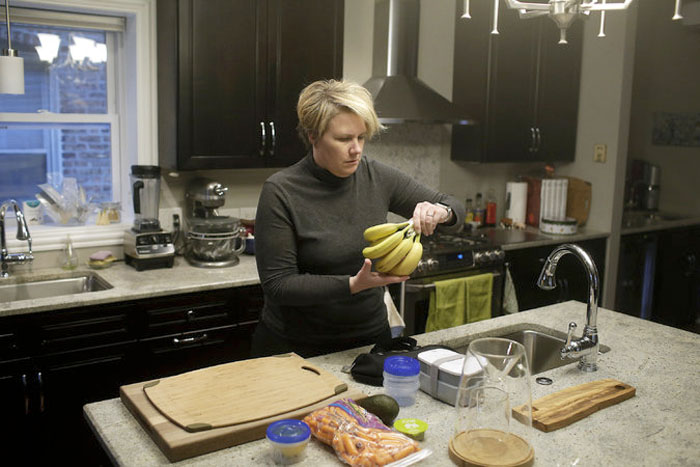
Gabrielle Novacek, a frequent business traveler, preparing food at home for a coming flight. Joshua Lott for The New York Times.
January 4, 2016
By JOSHUA BROCKMAN
Business travelers have plenty to think about when they fly. Once wheels come up, laptops land on the tray table. But diving into spreadsheets, business plans and email requires sustenance.
So, what’s on the airlines’ menu? Not much if you travel by coach, as does Mike DeFrino, chief executive of Kimpton Hotels and Restaurants.
“There’s nothing worse than a six-hour flight and being limited to Pringles on the plane or whatever prepackaged there is,” said Mr. DeFrino, who is based in San Francisco. “So, I always get something at the airport.”
As airlines continue to restrict food service for most passengers, frequent travelers are finding creative ways to stay nourished, hydrated and energized whether they are flying across the country or around the globe.
Mr. DeFrino takes a rather straightforward approach, buying a turkey-and-avocado sandwich at a deli in San Francisco International Airport before embarking.
He said he was mindful of the sardine can experience in coach, where passengers fly elbow to elbow. It requires a level of mutual respect, especially at mealtime, he said. That means not carrying on hot, steaming food like beef chow fun and anything else that smells up the cabin. A tuna salad sandwich? Forget about it.

Travelers at O’Hare International Airport in Chicago. Adrees Latif/Reuters.
For midflight snacks, Mr. DeFrino stocks beef jerky in his briefcase along with nuts, trail mix and nutrition bars.
Gabrielle Novacek, a Chicago-based partner with the Boston Consulting Group, is a business-class traveler who enjoys the same coveted status — American Airlines’ Concierge Key — as Ryan Bingham, George Clooney’s character in the 2009 movie “Up in the Air.”
A triathlon competitor, she prefers to create a traveling pantry. She packs her own meals with food from home that she supplements with purchases at the airport. She carries couscous or rice, mixed with some fresh vegetables or protein, which can be eaten cold. Her goal is to avoid salt, fat, preservatives and processed foods.
“I always call it shopping for ingredients because it’s usually really tough to find a preprepared, preassembled meal,” she said. “But when you can find the bits and pieces of ingredients to pull together, you can have a pretty fulfilling meal.” She spoke after having a breakfast of chopped-up fruit from home paired with oatmeal from Starbucks during her weekly commute to La Guardia Airport from O’Hare in Chicago.
After passing through security, Ms. Novacek frequents a mini-grocery store, where she stocks her pantry — a Built black neoprene lunch bag — with Greek yogurt, low-fat cheese, and sandwiches with seitan or other vegan ingredients. She also carries organic MacroBars.
As an athlete, she is cognizant about staying healthy and hydrated, so she has an immune-system-boosting drink mix with breakfast before taking any flight longer than four hours.
Travelers are permitted to carry on solid foods, but the Transportation Security Administration prohibits carrying through the security checkpoint more than 3.4 ounces of consumable liquids or pastes including spreads, salsa and yogurt. Those items can be purchased beyond the security checkpoint, however, and carried aboard the plane.
International travelers have the added challenge of crossing many time zones, which can confuse the body clock.
Peter R. Huntsman, chief executive of Huntsman Corporation, a global chemical manufacturer, flies regularly from Houston to Asia, including China, India and Saudi Arabia, and Europe. He acclimates for these long hauls by adjusting his sleep cycle a day or two before his journey, running four to six miles each morning, and eating a diet that is 90 percent vegetarian with some fish.
Executives who fly first class or business class, as he does, have an obligation to use the time in the air effectively so that they can hit the ground running, he said.
“That means that you don’t get on and make the most of the alcohol and the volumes of food. Take advantage of the seat and the sleeping, and take advantage of being able to arrive rested and ready to go,” Mr. Huntsman said. “And that’s good economics.”
Mr. Huntsman, who has the invitation-only Global Services status on United, says he prefers the quality and variability of the menu offered by international carriers including Lufthansa, Air France and Singapore Airlines.
He creates his own menu by picking and choosing items for one light meal and a snack from what is offered. One dish that stands out is Emirates’ traditional Arabic mezze, which combines hummus, moutabel and stuffed vine leaves.
Leila Janah, the chief executive of Sama Group and Laxmi, flies on airplanes so much that she lists her location on Twitter as San Francisco “or a suitcase.” The nonprofit Sama Group helps people escape poverty by connecting them to work that pays a living wage, among other ventures. Laxmi, a for-profit company that shares Sama’s social mission, sells luxury skin care products.
Ms. Janah said her travels to Kenya, Uganda and Rwanda dictate that she compromise her diet: “I’m 80 percent raw and vegan and then 20 percent whatever because I travel so much to a lot to poor countries where people make a huge effort to provide me with food.”
She carries on her own chai tea bags, which she brews in a stainless steel insulated water bottle, and also takes dried fruits and nuts, along with organic and gluten-free energy bars.
“I basically eat like a hunter-gatherer when possible,” she said. “I find that’s the only way to keep my body regulated.”
Read original article, which appeared in Business Day on p. B6.
© The New York Times Company
